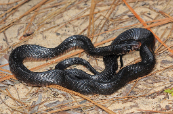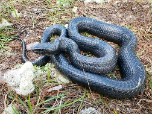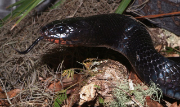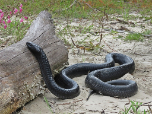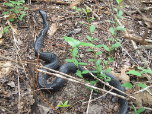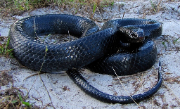|
Eastern Indigo (Drymarchon couperi)
Description: Eastern indigo snakes are the largest snakes in the United States and the largest, non-venomous snakes in the southeastern United States. Eastern indigo snakes are uniformly black with the exception of a red or cream colored area on the chin, throat, and, occasionally, the cheeks. The scales are smooth and large, typically with 17 scale rows at the mid body. Adults typical reach between 157.2 and 213.36 cm long. The record, however, is 280.4 cm long. Eastern indigo snakes are sexually dimorphic, with males growing longer than females. Eastern indigo snake young are similar in appearance, with the exception of a white band around their body. These snakes are commonly confused with with racers. Racers differ from eastern indigo snakes in several aspects: racers are rarely over 121.9 cm long, they are often thinner and have a dull black coloration with white or brown throats.
Habitat: Eastern indigo snakes can be found in a variety of environments including pine and scrubby flatwoods, high pine, dry prairie, tropical hardwood hammocks, edges of freshwater marshes, agricultural fields, coastal dunes, and human-altered habitats. These snakes thrive more in wetland environments, as opposed to xeric conditions. Often eastern indigo snakes can be found living in the same habitat as gopher tortoises. Eastern indigo snakes use gopher tortoise burrows for shelter in the xeric habitats where gopher tortoises are found. In more moist habitats, eastern indigo snakes take shelter in hollowed root channels, hollow logs, or the burrows of rodents, armadillos, or land crabs. One study (Smith 1987) concluded that eastern indigo snakes live in different habitats throughout the year and at different stages of their lives.
Range: The eastern indigo snake inhabits areas from far southwestern South Carolina through Florida, and west to southern Alabama and southeastern Mississippi.
Found in these States:
AL |
FL |
GA |
MS
Diet: Eastern indigo snakes consume a variety of food sources. They have one of the most varied diets of any snake. Eastern indigo snakes eat mammals, frogs, lizards, fish, eggs, birds, and other snakes, including venomous snakes. Eastern indigo snakes are immune to the venom of sympatric species of venomous snakes. Interestingly, they are one of the only snakes known to eat young turtles. Like other snakes, they typical eat their prey while it is still living. However there has been recorded cases of an eastern indigo snake beating prey against a nearby object to kill it. Eastern indigo snakes do not constrict their prey, they typically overpower it until the prey is exhausted to the point at which it can't escape, sometimes immobilizing the prey by pressing it to the ground. Their powerful jaws are used to grasp and pin down their prey until it can be ingested.
Reproduction: Female eastern indigo snakes signal their readiness to mate by producing pheromones. When the scent is picked up by a male indigo snake, they track down the scent until they come into contact with the female. If other males are present, they will typically engage in ritual combat dances. During these dances, both males will intertwine their bodies and try to force the other's head to the ground. The winner mates with the female. Eastern indigo snakes have a polygynandrous mating system; males and females have multiple mates.
In northern Florida, where most research on reproduction cycles has been conducted, the breeding season is from November to April. Females deposit their eggs from May to June. Females lay from 4 to 12 eggs, usually in vacated animal burrows, such as those of gopher tortoises, fallen logs, or some other sheltered burrow. Young hatch in about 3 months, usually in August and September. The breeding season may be extended in parts of south central Florida.
Eastern indigo snake hatchlings are born at an average size of 30.48 cm long. They grow rapidly and often reach adult size in 2 to 3 years. Eastern indigo snake females invest in young through supplying the egg and finding a safe place to lay their eggs. There is no further parental investment.
Status: In 1978, eastern indigos were federally listed as a threatened species under the Endangered Species Act. Threats to the snake included loss of habitat, which continues today, and over-collection for the pet trade. Eastern indigos have largely been eliminated from North Florida due to habitat loss and fragmentation. Few if any indigos persist in North Florida. Populations in other parts of the state, although declining, still have strongholds in warmer Central and South Florida, where it rarely drops below freezing.
»» Kingdom: Animalia - Animals
»» Phylum: Chordata - Chordates
»» Subphylum: Vertebrata - Vertebrates
»» Class: Reptilia - Reptiles
»» Order: Squamata - Scaled Reptiles
»» Suborder: Serpentes
»» Superfamily: Colubroidea
»» Family: Colubridae - Colubrids
»» Genus: Drymarchon
»» Species: Drymarchon couperi - Eastern Indigo
This article uses material from the Wikipedia article "Eastern Indigo Snake", which is released under the Creative Commons Attribution-Share-Alike License 3.0. Content may have been omitted from the original, but no content has been changed or extended.
|
|


